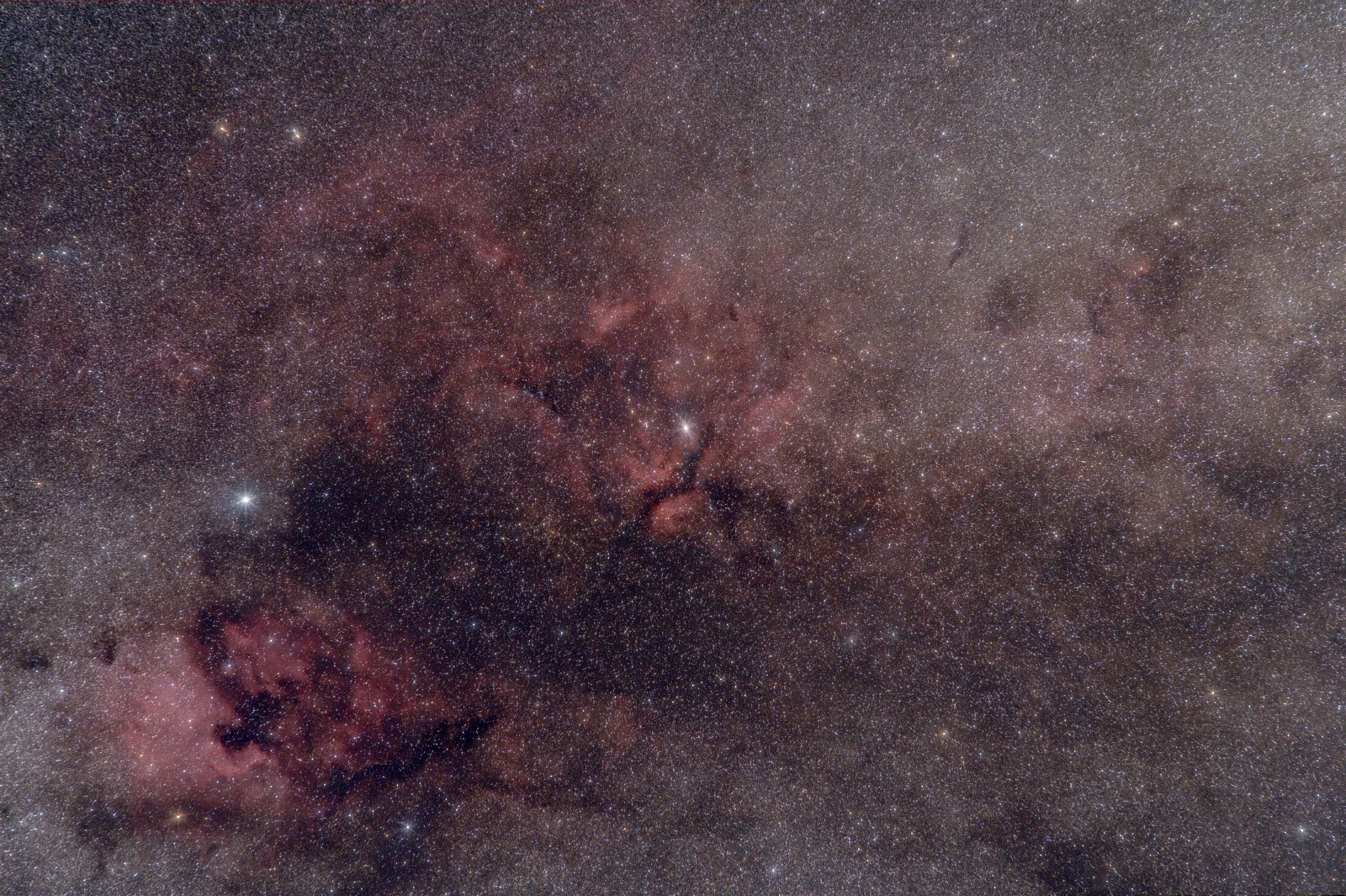
In the image above, north is to the left and west is up.
The central part of the constellation Cygnus is a beautiful Summer Milky Way area full of innumerable multi-colored stars and many large emission nebulae, most of which are located quite nearby in the Cygnus arm of our galaxy. The region is dominated by two bright stars: Alpha, called Deneb, is the bright star located in the upper right quarter of the picture; and Gamma, called Sadr, which is located just above the image's center. The naked eye appearance of Cygnus is quite impressive, no less than 146 individual stars are visible to the unaided eye in a clear summer night. The areas in Cygnus where appear to be less stars are in fact obscured by dust in the spiral arm.
With a decent rich-field telescope a skilled observer is able to observe the brighter emission nebulae apparent in this photograph. There are too many emission nebulae in this image to give the individual numbers, but three major groups are distinguishable: The North American/Pelican Region east of Dene (in the lower left corner of this image), the γ Cygni Region around Sadr (center), and fainter stuff southwest (above) Deneb. The best-known members of the first group are the North American Nebula NGC 7000 with its unmistakable resemblance to the North American continent, and the Pelican Nebula IC 5067-5070 located in "mid-Atlantic" relative to NGC 7000, so to speak. The most prominent member of the γ Cygni nebulosity are IC 1318, the bi-sected Butterfly Nebula immediately northeast of Sadr and NGC 6888, the small Crescent Nebula three degrees south and slightly west of Sadr (a small arc of nebulosity).
 The Milky Way in Cygnus, zoom lens photograph
The Milky Way in Cygnus, zoom lens photograph
 LBN 242 and Surrounding Nebulosity, Western Cygnus, telelens photograph
LBN 242 and Surrounding Nebulosity, Western Cygnus, telelens photograph
 γ Cygni Nebulosity, Wright-Newtonian CCD-image
γ Cygni Nebulosity, Wright-Newtonian CCD-image
 NGC 6914 and vdB132 Region, Wright-Newtonian CCD-image
NGC 6914 and vdB132 Region, Wright-Newtonian CCD-image
 NGC 7000 - North American Nebula, Wright-Newtonian CCD-image
NGC 7000 - North American Nebula, Wright-Newtonian CCD-image
 IC 5068, Wright-Newtonian CCD-image
IC 5068, Wright-Newtonian CCD-image
 IC 5067-70 - Pelican Nebula and Surrounding Nebulae, Wright-Newtonian CCD-image
IC 5067-70 - Pelican Nebula and Surrounding Nebulae, Wright-Newtonian CCD-image
 Sharpless 92 and Environment, CMOS image
Sharpless 92 and Environment, CMOS image
 Sharpless 101 - Tulip Nebula and Environment, Wright-Newtonian CCD image
Sharpless 101 - Tulip Nebula and Environment, Wright-Newtonian CCD image
 Sharpless 112, Sharpless 115 and Abell 71, Wright-Newtonian CCD image
Sharpless 112, Sharpless 115 and Abell 71, Wright-Newtonian CCD image
 van den Bergh 130 and Environment, Triplet telescope image
van den Bergh 130 and Environment, Triplet telescope image
 WR 134 - Wolf-Rayet Bubble in Cygnus, Wright-Newtonian CCD image.
WR 134 - Wolf-Rayet Bubble in Cygnus, Wright-Newtonian CCD image.
Exposure Data